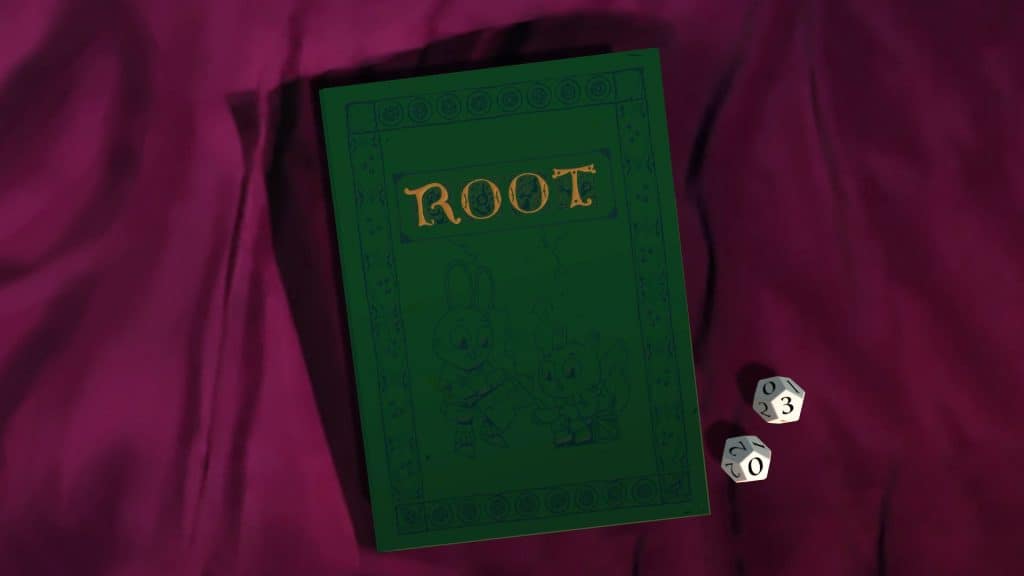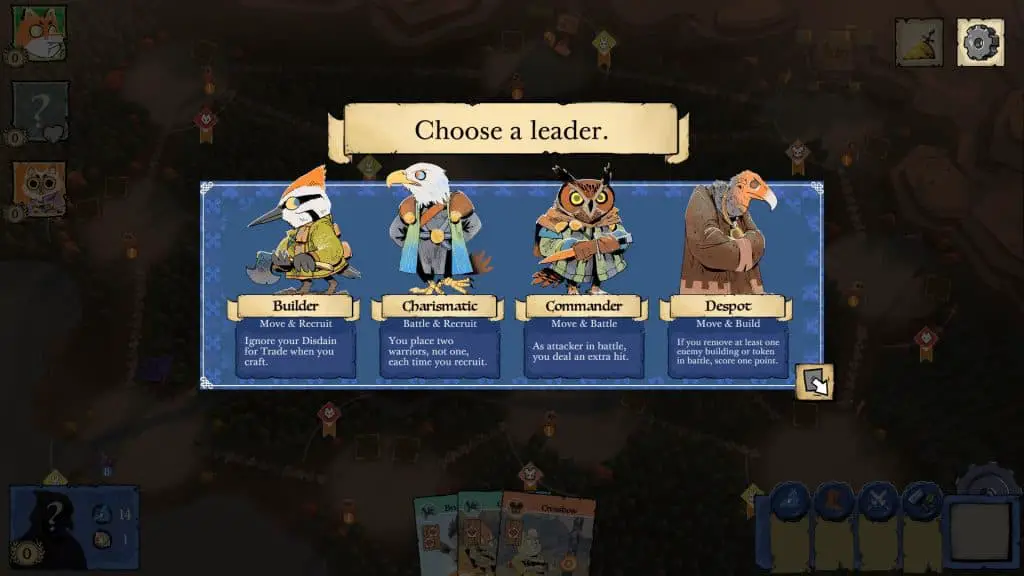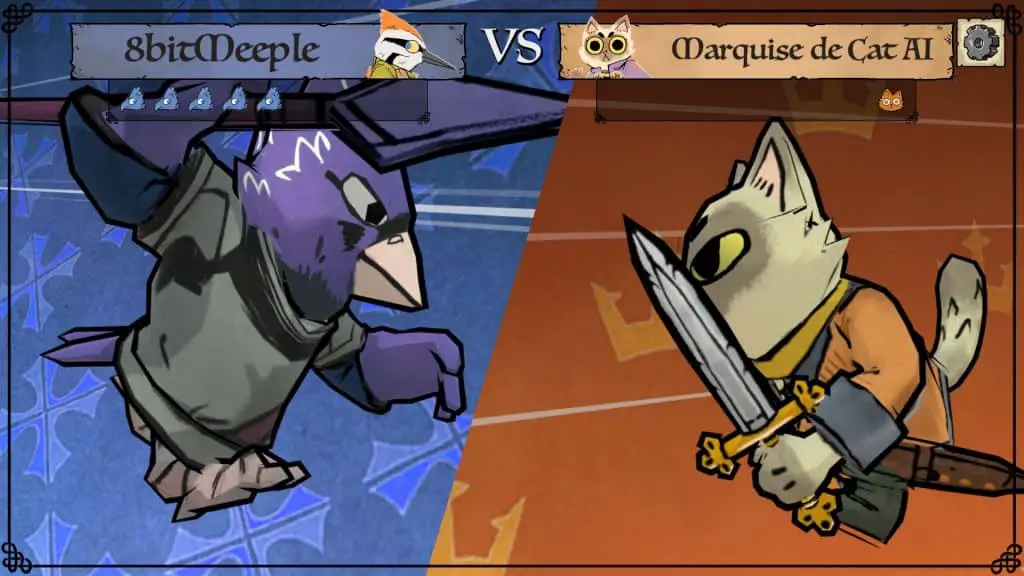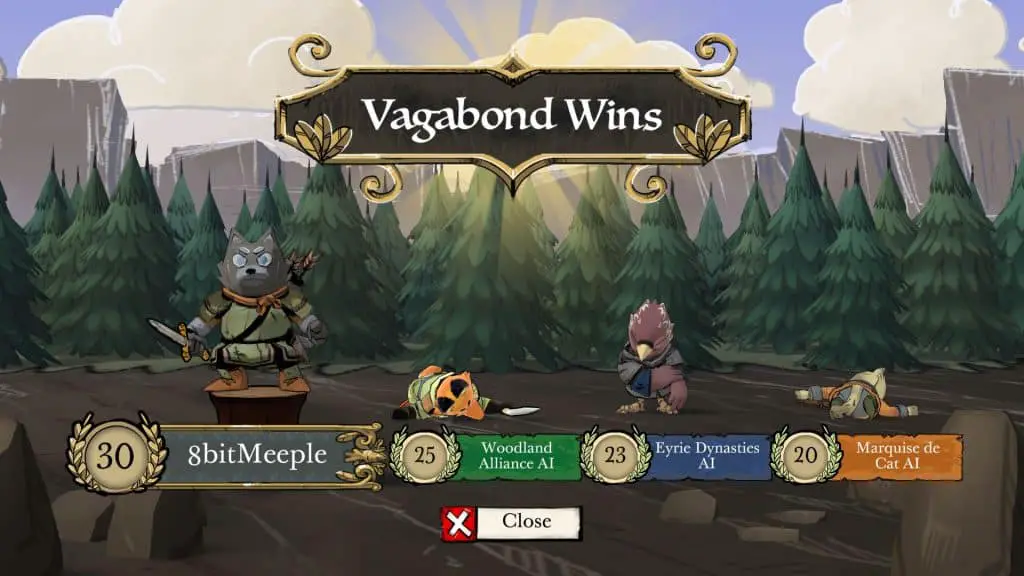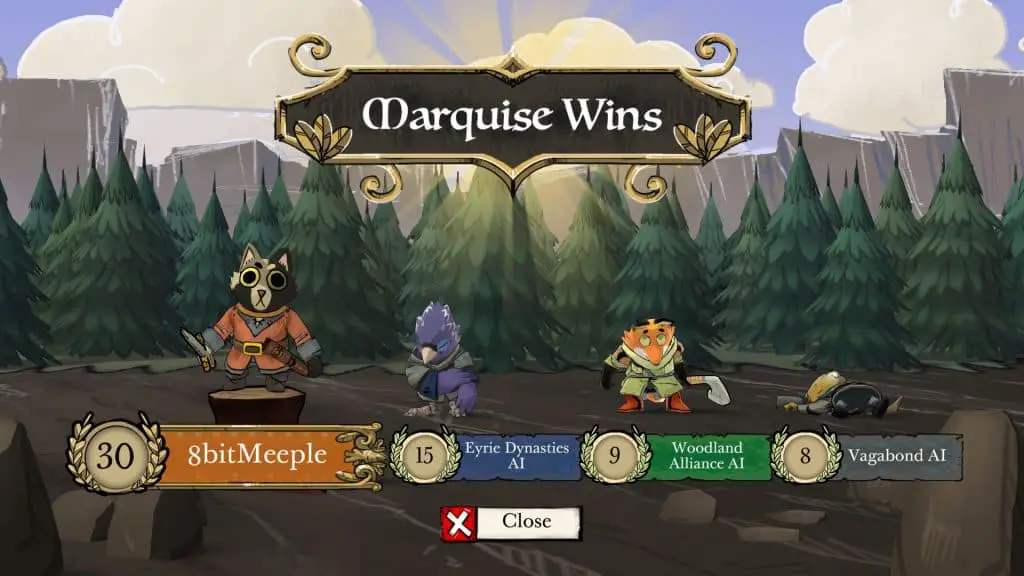Review: Root App Review
Prepare to choose you faction and decide whether Root will take over your device or whether it’s dynasty will crumble down.
The battle for the woodland is about to commence and Root has you deciding on which side of history you want to be on. Root sees you taking charge of one of four different factions (the Marquise de Cat, the Eyrie Dynasties, the Woodland Alliance and the Vagabond) and challenges to utilise their unique win conditions and abilities in order to gain enough victory points to take control of the forest. What makes Root special and different to most of the board game apps we’ve seen to date is the fact that it is a true asymmetrical game; that means that each faction has it’s own set of rules, it’s own pieces and abilities and even their own way to win, all while existing in the same world and on the same board. If you think that sounds tricky to get your head around then just wait until I start to give an overview of the rules!
Explaining in depth all of the rules for Root is akin to me explaining 4 separate games, that is how differently each player will play in Root; and so I won’t go into too much depth here how everything works and instead will try and give a bit of an overview of how each faction plays; however don’t worry because the digital version of the game comes with a complete tutorial which walks you through everything.
Probably the easiest faction, and the one which is most like other games I’ve played is the Marquise de Cat; which plays in a similar way to a lot of other economic board games. As the current dominant faction in the start of the game, the Cats control all but one of the forest clearings (which act as our battle grounds for this game) and they make their points in the traditional method of building up their civilisation. Construct buildings to gain resources, use resources to construct more buildings, recruit troops to defend buildings and so on. Gain victory points for building more and more buildings and slowly build up your civilisation until you hit 30 VP and win the game. It’s a set of mechanisms you’ll recognise and a faction that you can easily see how you are going to get the points you need to win the game.
While the Marquise de Cat may be the current dominant faction in the forest, the former power of the Eyrie Dynasties lies in wait in it’s single forest clearing preparing to reclaim it’s fallen glory by building roosts throughout the forest. The Eyrie function by utilising a government and creating an ever expanding decree for their faction to follow. This decree is made up of four potential actions (Recruit, Move, Battle and Build) and each turn the Eyrie must add at least one of these actions to their decree. The Eyrie player must complete every action on their decree or their government will collapse and they will lose VP. This creates a fascinating effect of building up momentum for the Eyrie player as they get more and more actions to do each turn, spreading further and further through the forest before collapsing under the weight of their own decree and losing a bunch of the ground they have made only to have to start the slow process of building their decree again. Can you swing enough momentum to push yourself over the finish line or will you fall just short and get over taken at the end as you try to build up steam once more?
Very much the upstart faction to the previous power houses, the Woodland Alliance starts with no presence on the board itself however begins slowly building up support from frustrated woodland creatures who have come under the rule of the Marquise de Cat and the Eyrie Dynasties. As the Woodland Alliance you gain victory points by sewing sympathy across the land, utilising that sympathy to perform rebellions and gain a foot hold on the board. While maintaining a presence for battle is nice, unlike the Cats and the Eyrie, the Woodland Alliance need only gain enough sympathy amongst the creatures in order to claim it’s victory. In an area control game like Root it’s interesting to play as a faction that doesn’t have to spend it’s time maintaining an offensive and defensive force and instead can build up opportunities to flip a clearing into their favour simply by sewing sympathy and utilising cards they gain from other players as they frustrate the forest locals; seeing a large group of Cats wiped from the board without the need to fight thanks to a rebellion essentially funded by the Cat’s previous actions, is deeply satisfying.
Finally, and perhaps the most different of all of the factions, the Vagabond wonders the forest, unconcerned with gaining control itself and disinterested in fighting, instead aiding each faction on their own quest for forest domination but never enough to push them to victory before the Vagabond itself can claim it. The Vagabond moves within the forest itself, completing it’s own quests, collecting items and giving aid to the other factions all in exchange for VP. While never directly involved in the fighting going on between the factions, the Vagabond player has a key role to play in assisting the other factions, be it providing support to the Woodland Alliance in the form of additional allies or clearing ruins for the Cats in order for them to constructing their buildings. It can be a lonely life as the Vagabond however making friends eases the pain while also gets you one step closer to victory.
These 4 factions co-exist on a board which is tight, with only 12 forest clearings to compete for and limited places to build either roosts or buildings, and are all attempting to win in such unique ways that if you don’t pay attention they can win without you realising they were as close as they were.
There’s other nuances to a game of Root that I haven’t covered here, a deck of cards which can be used in battle, to collect items or to craft for victory points as well as a day and night phase in which only certain actions can be used. It’s a game that takes some time to get your head around and be able to understand the progress of each of the factions at a glance but not so tricky in rules and mechanics that it is a difficult game to learn.
My biggest criticism for the physical version of Root was that it was such a challenge to get it to the table regularly enough to be able to get comfortable with each faction and start developing strategies to win. Finding 3 other players with both the time and willingness to not only learn the rules for 4 different factions but to also want to play them regularly enough to practice was rare. As such the release of Root Digital marks a huge step in getting the game played.
In comparison to the physical version, Dire Wolf Digital have done the kind of job we’d expect in porting the presentation to the digital tabletop. As with their previous app versions of board games, specifically Raiders of the North Sea, they have rendered the previously 2D board into a 3D world, rich in detail, a wealth of animation and true to the art style of the source material. Root looks fantastic and the artwork from the board game is fantastically represented in the game from the cards, character models to the menus, including the musical band of Vagabonds who play the theme music on the main menu. The attention to detail is impressive and it makes Root one of the best looking board game apps out there, however it’s not without it’s minor complaints.
To accompany the excellent presentation, various play options have been included for both solo player and multi player with online play as well as local pass and play options, 3 levels of AI as well as a series of challenges designed to put your abilities with each faction to the test with various special objectives required to win a game. Multiplayer works as smoothly as you’d expect if you’ve played any other board game apps from this developer and the inclusion of challenges is a welcome one. The AI in the game however, has been somewhat of a mixed bag; the easy AI feels more of a training partner, posing little challenge but providing you with a safe opportunity to test out and learn the nuances of each faction in a real time game. The medium AI is a little better however still suffers from some unusual decision making (moving units back and forth between the same clearings, even at a cost of a card to the Woodland Alliance each time) and like the easy AI struggles to identify how close other players may be to winning.
The easy and medium AI feel as though they are playing a game of solitaire, making decisions which are optimised for gaining them the most victory points on a single turn rather than including what other factions are doing into their decision making. Too often I would be left to single handedly prevent opponents from winning by dominance or keeping factions in check when the AI could have easily quashed the threat on their turn far more easily than I could. The hard AI does a better job and while I win more often than I lose it provides a reasonable challenge that makes the game fun without being too punishing. I fear that now I have the chance to play Root more often thanks to this implementation, that I will soon out grow the AI in the game as it currently is.
Despite all of that, Root Digital is a tonne of fun and lives up to the hype which made it my most anticipated game of the year. Dire Wolf Digital have built a back catalogue of board game adaptations which not only look great but also are enjoyable to play over and over again and Root sits atop of that bunch as probably their best looking and most fun to play. The asymmetry in the game means there is so much for you to do, be it balancing a bloated government or playing in in your own RPG while a war is going on around you. Getting the chance to play a game I enjoy in app format is always a treat however it is especially so when it’s a game that I so rarely get the chance to play and as such Root Digital is an absolute godsend for fans of the original.
My biggest concern with this game, is one which I also have seen play out with Raiders of the North Sea, and that is the longevity of the game using the base set alone. Raiders of the North Sea was a game I thoroughly enjoyed and the app version was a great adaptation, however as time went on I felt it was crying out for the expansions to be added to the game as the base game had lost some of it’s magic over repeated plays; my moves became predictable and it felt more like I was playing the same game over again. The physical version of Root has a plethora of expansions which add much needed variety through new factions and battlegrounds as well as tweaks and updates to existing factions. Having these expansions added to Root would provide some variety in game play and really extend the longevity of the game and as such I’m hopeful that we may see these added in the future.
Regardless of any potential expansions, Root Digital is a triumph of a board game adaptation, bringing a much beloved game into app format. Being able to play Root regularly and in such a well presented package, even at an early release stage, is something I have been looking forward to, and Dire Wolf Digital did not disappoint. If you are already a fan of the board game, or have always wanted to try it but didn’t have the people to play against, then I thoroughly recommend Root to you.

